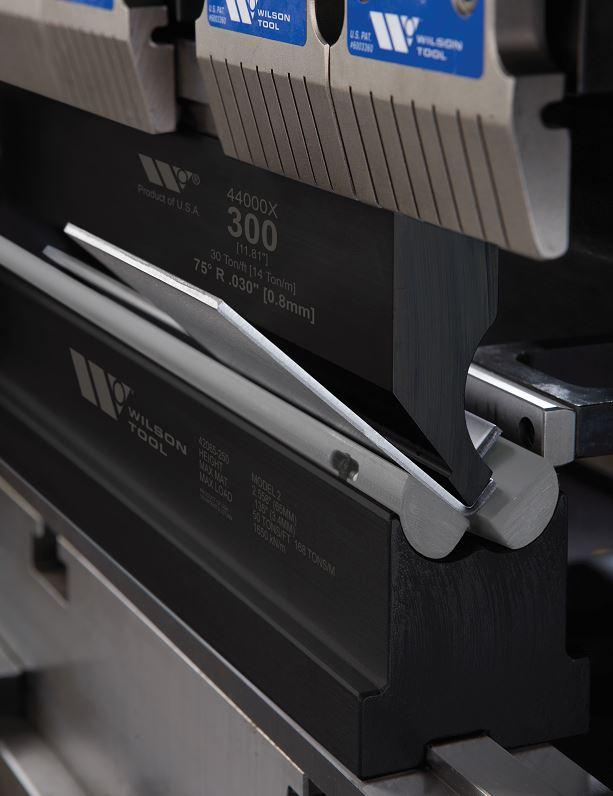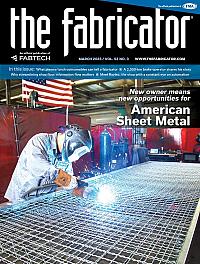Contributing editor
- FMA
- The Fabricator
- FABTECH
- Canadian Metalworking
Categories
- Additive Manufacturing
- Aluminum Welding
- Arc Welding
- Assembly and Joining
- Automation and Robotics
- Bending and Forming
- Consumables
- Cutting and Weld Prep
- Electric Vehicles
- En Español
- Finishing
- Hydroforming
- Laser Cutting
- Laser Welding
- Machining
- Manufacturing Software
- Materials Handling
- Metals/Materials
- Oxyfuel Cutting
- Plasma Cutting
- Power Tools
- Punching and Other Holemaking
- Roll Forming
- Safety
- Sawing
- Shearing
- Shop Management
- Testing and Measuring
- Tube and Pipe Fabrication
- Tube and Pipe Production
- Waterjet Cutting
Industry Directory
Webcasts
Podcasts
FAB 40
Advertise
Subscribe
Account Login
Search
Achieving sharp bends in aluminum with the right tooling
Bend without cracking, reducing or eliminating galling, and preventing marking
- By Kate Bachman
- March 10, 2023
- Article
- Bending and Forming

Because aluminum is a softer metal than steel, care must be taken to prevent or minimize scratching, galling, and marking it during bending. Highly polished and coated press brake tooling tends to reduce the likelihood of marking, inaccuracies, and galling. LVD
Aluminum is being used increasingly in manufacturing and metal fabrication for its lightweighting and noncorrosive properties. Fabricating aluminum brings with it a few challenges unique to bending and forming—getting sharp bends, for one. As with any metal, fabricators must be vigilant in preventing cracking in the bends. Fabricators also need to take measures to reduce or eliminate galling. Because aluminum is softer than steel, it is more prone to marking, which is especially problematic on appearance parts.
Sometimes, tooling approaches can resolve or ease these problems. Press Brake Manager Lieven Vanhoenacker, LVD Co. NV; Bending Product Manager Steven Brown, Wilson Tool Intl.; and President David Foscarini, Mecon Industries Ltd., offer advice and additional tips on how to apply tooling to three aluminum bending problems.
How can press brake tooling help resolve challenges with performing sharp bends in aluminum without cracking?
Steven Brown, Wilson Tool: "What's the best way to bend aluminum?” is a common question. Because bending is forming, the query can best be answered if it includes which grade of aluminum you want to form. Each grade has distinct qualities that will drive the tooling decision. If the question is, “How can I bend 5052-H32?” now, that is valuable information that allows us to provide an answer.
Without being a metallurgist, you can identify the aluminum grade by its name. The first four characters give the material makeup. For example, 3030 indicates 97.6% aluminum, 0.35% iron, 0.15% silicon, 0.10 to 0.70% manganese, 0.10 copper, 0.050 to 0.50 zinc and other trace elements. The percentage of silicon may provide clues to the material’s hardness and pliability. The alloy composition of 6061 aluminum is 97.9 % aluminum, 1.0 % magnesium, 0.6 % silicon, 0.28% copper, 0.2% chromium and other trace elements. The percentage of silicon and chromium may provide clues to the material’s hardness and pliability.
Going even further, you can focus on the characters after the hyphen. They call out the hardness:
O = Soft; H = Half Hard; T = Treated (Hard)
- 3030-O
- 5052-H32
- 6061-T6
Bending a sharp inside radius (IR) in soft and half-hard aluminum isn’t usually much of a challenge. Because O and H are considered soft, those materials are probably going to bend easily while air bending. The punch tip and the IR can be tighter because the material is more elastic.
The challenge is in bending the hard aluminum grades. If the aluminum is T, meaning hard, the material will be too hard to yield to the punch tip, so the IR should be three times the material thickness (MT), and preferably the aluminum should be bent against the grain.
There really isn’t a silver bullet that allows you to form a small radius in material that is so hard it tends to stress and crack. Hard aluminum grades simply need a larger IR. You don’t spend the money on hard aluminum to just accept stress fractures. In hard aluminum, cold forming 1 x MT is not realistic.
Lieven Vanhoenacker, LVD: Precision-ground punch and die sets can provide a precise and accurate bending point. This high precision helps with forming sharp bends in aluminum. Also important is the use of a modern, high-accuracy press brake that can hold tight alignment of the punch and die.

There are certain tooling tactics that can be applied to achieve sharp bends, but primarily, it depends on how hard the aluminum grade is. LVD
In addition, using the correct type of bending tooling for the application—such as air bending, coining, or bottoming—can help create sharper bends in aluminum. Too, using a lubricant specifically designed for aluminum can minimize friction and prevent cracking and tearing during the bending process.
While a state-of-the-art press brake with reliable repeatability and modern tooling with high tolerances are important, sheet metal tolerances will vary, and this may present the most significant bending challenge.
Elongation at break is the measurement of how much a material can be stretched before it breaks as a percentage of its original dimensions. It is different for every material. Each material reacts differently in terms of force calculation and elongation. There are many grades of aluminum and aluminum alloys, and new alloys continue to be developed. Using data sheets provided by the material supplier will help produce desired bending results, and consulting with the tooling supplier/manufacturer about your application is also a good idea.
David Foscarini, Mecon Industries: First, choose the correct grade of aluminum. The grade encompasses the chemical formulation and hardness. Many grades of aluminum just don’t have the formability of most steels.
Second, use larger than standard lead-in radii.
How can press brake tooling be modified to help to prevent part marking on aluminum?
Vanhoenacker: LVD offers a radius tooling called STONE [shaped tooling for optimal bending without wear]. A unique grinding process produces a special radius of “logarithmic spiral” design instead of one single radius on each side of the V die. The curve is made in a succession of multiple radii. This allows the sheet to roll more symmetrically into the V die using less force while reducing friction between the material and the tooling. STONE tooling diminishes the marks, nicks, and carbon deposits that can occur on the workpiece as the material rolls through the die.
You can use a tooling material with a low friction coefficient so that the die and material more easily slide over each other to help prevent part marking.
You should apply a lubricant, such as a wax or an oil-based lubricant.
Use tooling with a polished surface. Die surfaces that are polished minimize marking and reduce drag.
Finally, distribute the pressure of the punch over a larger area.

Allowing the die shoulders to pivot with flat material siding on a flat surface prevents marking. Wilson Tool
Foscarini: If possible, use a larger-than-standard opening. Polish the lead-in radii. Use a barrier film to prevent metal-to-metal contact.
Brown: You can address part marking problems with large shoulder radius dies. If the radius is less than two material thicknesses, try increasing the die’s shoulder radius. The larger radius will allow the material to flow instead of scrape. Plus, it will be easier to keep tooling clean. If a mark-free bend is preferred, urethane or cloth drape can be used on the die to protect the material.
How can tooling reduce galling?
Foscarini: We manufacture a line of standard press brake tooling. These tools are made to a set of standard dimensions and are made on a semi-production basis to keep the cost low. But if a client has a need to form specific parts and materials that our standard tooling doesn’t meet, we make suggestions to improve the process.
One of these suggestions would be to increase the size of the tool’s lead-in radii, which are the rounded edges on the bottom die. Making them bigger spreads the forming load. This reduces galling, scratches, and marking, along with polishing. The tool’s radii should be polished to 32 µin or better.
An excellent finish on the die goes a long way toward reducing marking and galling by smoothing the material flow into the die.
Brown: Galling is a result of the press brake die shoulder radius grabbing at the material being bent, which results in residue buildup. You need to stop, or at least reduce, the grabbing action of the die shoulder. Again, if the radius is less than two material thicknesses, try increasing the die’s shoulder radius to allow the material to flow. You still might get gall buildup, but at a much slower rate. Again, a urethane or cloth drape on the die can help protect the material.
Vanhoenacker: First, make sure that the tooling material is harder than the material being formed.
Use a lubricant specifically designed for the work material. Not only will the lubricant prevent friction between the part being formed and the tooling, it will protect the tooling from corrosion. Choosing a lubricant that is compatible with the aluminum alloy helps ensure best results. This can be a mineral- or a renewable-resource, oil-based lubricant.
Use a special coating on the tooling. Bending tools that are coated reduce the likelihood of marking, inaccuracies, and galling. Coated tools are also easier to maintain.
Again, use a special logarithmic radius on the die, such as LVD’s STONE radius tooling.
About the Author

Kate Bachman
815-381-1302
Kate Bachman is a contributing editor for The FABRICATOR editor. Bachman has more than 20 years of experience as a writer and editor in the manufacturing and other industries.
Related Companies
subscribe now

The Fabricator is North America's leading magazine for the metal forming and fabricating industry. The magazine delivers the news, technical articles, and case histories that enable fabricators to do their jobs more efficiently. The Fabricator has served the industry since 1970.
start your free subscription- Stay connected from anywhere

Easily access valuable industry resources now with full access to the digital edition of The Fabricator.

Easily access valuable industry resources now with full access to the digital edition of The Welder.

Easily access valuable industry resources now with full access to the digital edition of The Tube and Pipe Journal.
- Podcasting
- Podcast:
- The Fabricator Podcast
- Published:
- 04/16/2024
- Running Time:
- 63:29
In this episode of The Fabricator Podcast, Caleb Chamberlain, co-founder and CEO of OSH Cut, discusses his company’s...
- Industry Events
16th Annual Safety Conference
- April 30 - May 1, 2024
- Elgin,
Pipe and Tube Conference
- May 21 - 22, 2024
- Omaha, NE
World-Class Roll Forming Workshop
- June 5 - 6, 2024
- Louisville, KY
Advanced Laser Application Workshop
- June 25 - 27, 2024
- Novi, MI
































